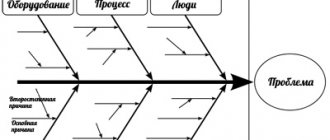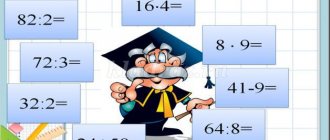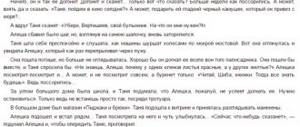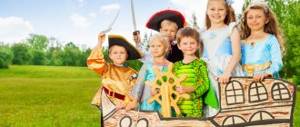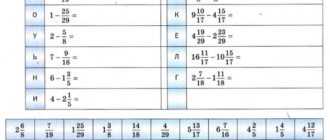Motivational techniques at the first stage of a modern lesson in primary school
*Slide Motivational techniques at the first stage of a modern lesson in primary school
Currently, in modern schools the task of increasing learning motivation is quite acute, since motive is the basis of any effective activity. Motivation is necessary both at the beginning of the lesson and at any stage. There is a motive, there is activity, there is joint work, which means there is a result.
Motivation is designed to concentrate students' attention on the material being studied, to interest them, and to show the need or benefit of studying the material. The effectiveness of students’ assimilation of educational material largely depends on motivation.
*Slide The structure of a modern lesson in primary school consists of several stages:
Motivation for educational activities (organizational moment)
Updating and recording individual difficulties in a trial learning activity
Setting a learning task
Discovery of new knowledge (construction of a project for getting out of a difficulty)
Independent work with self-test using a sample (standard)
Incorporation of new knowledge into the knowledge system and repetition
Reflection on learning activities in the lesson (result)
Teachers know that a student cannot be taught successfully if he is indifferent to learning and knowledge, without interest and without realizing the need for it. In my opinion, a good start to a lesson is the key to a great finish. Therefore, the task of developing a child’s desire to learn and achieve excellent results largely depends on the development of motivation precisely at the first stage of the lesson.
The main goal of motivation for educational activities at the first stage is to develop, at a personally significant level, internal readiness to fulfill the regulatory requirements of educational activities.
To achieve this goal it is necessary:
— create conditions for the emergence of an internal need for inclusion in activities (“I want”);
— update the requirements for the student in terms of educational activities (“must”);
— establish the thematic framework of educational activities (“I can”).
There are various ways and techniques to increase motivation. Over many years of teaching, several motivational techniques have been identified that work successfully in practice.
For example, the most important stimulus for educational activity is a favorable psychological climate. When going to class, you always need to think through your first phrases: “Good morning! I'm glad to see you", "Hello! Today is a wonderful day,” “Good afternoon! We are starting the lesson." These words relieve the child’s psychological constriction. Removing fear is the step that leads a student to success, and success maintains and fuels motivation.
Game as a means of motivation in mathematics lessons in primary school
Without pedagogical play in the classroom, it is impossible to captivate students into the world of knowledge and moral experiences, to make them active participants and creators of the lesson.
Sh. A. Amonashvili [1, 15].
Without play there is not and cannot be full-fledged mental and psychological development. As V. A. Sukhomlinsky notes, “A game is a spark that ignites the flame of inquisitiveness and curiosity” [3, 272]. It begins not with a count, which seems obvious, but with a riddle, a problem. For a student to develop creative thinking, it is necessary for him to feel surprise and curiosity, and to repeat the path of humanity in knowledge. Only through overcoming difficulties and solving problems can a child enter the world of creativity. Learning mathematics should not be a boring task for a child. The fact is that children's memory is selective. A child learns only what interests, surprises, makes him happy or frightens him.
There are several main goals that encourage teachers to use games as one of the main methods for developing mathematical skills:
− Educational (knowledge, abilities and skills acquired in the process of explaining new material);
− Developmental (stimulation of cognitive interest, development of the ability to compare, juxtapose, identify, generalize, draw conclusions);
− Educational (cultivating a sense of responsibility, conscious collectivism during the game).
Each game has a structure:
1) goal - what we check, what we consolidate, what we study;
2) rules - the conditions of the game and how to perform it;
3) game actions.
The use of games occurs at different stages of the lesson. When explaining new material, during partial search tasks, when generalizing and consolidating.
It is also important to note that types of educational games play a significant role in mathematics lessons - these are visual (handouts, demonstration diagrams, any illustrative material) and verbal materials. Subtypes of educational games include individual, group and collective games.
Let's look at several types of games used in elementary school to develop mathematical skills.
1. Astronauts.
In this game, the class is divided into 3 crews according to the number of rows. On the first desk, each team has a rocket with examples. This game is a group game, during the game (correct solution of problems, one of the three teams wins). This game, in addition to systematizing mathematical skills, also promotes the development of collective thinking and group work.
2. Train.
Pictures in the form of train cars are hung on the board; you need to sort the numbers from 1 to 10. Each car has a specific number marked on it, all the numbers in a different sequence. Students are required to put the numbers in the correct order. This game is designed for both a group of three teams and the class as a whole.
3. New Year tree.
A figure of a Christmas tree is hung on the board, children come up to the board and take a figure of a Christmas tree toy, on the back of which there is an example that needs to be solved correctly in order to hang it on the Christmas tree. The game "New Year's Tree" can be used both for practicing individual mathematical skills and for working in a group, when each group of three has its own Christmas tree posted on the board, which they must decorate, and the more toys on the Christmas tree, the more points the team gets.
4. Sunny.
The central circle of the sun indicates examples that need to be solved. As each example is solved, the answer appears in a ray. The game can be either collective or group, when each of the three groups has its own sun with examples posted on the board.
5. Collect a flower.
A flower without petals is hung on the board. The petals are arranged in different sequences, each petal has a number from 1 to 10 marked on it. We practice counting both in a group and collectively.
Based on the above examples, we can conclude that the most interesting and motivating tasks are those whose focus is collective or group. Students are willingly involved in solving problems where group play is a motivating factor. Thus, two pedagogical goals are solved - educational (learning to work in a group and team), developing (development of cognitive thinking, implementation of mathematical skills). During play, children are attentive, focused, and disciplined. Kovalenko V.G. believes that mathematical games go very well with “serious” learning. The use of game methods in mathematics lessons makes the learning process interesting and entertaining, creates a working mood in children, and makes it easier to overcome difficulties in mastering educational material. Play should be considered as a powerful, indispensable lever for a child’s mental development [2, 90].
It is also important to note the fact that the use of games to develop mathematical skills must be accompanied by visual material. Despite the fact that there are two types of games (visual and verbal), as mentioned above, visual or demonstration games always have the best result, that is, the best level of student involvement in the process. The game should be accompanied by visual material (rocket, sun, train, etc.), handouts (mostly if we are developing individual mathematical skills).
We also note that the game should not distract the student from the educational process, but rather should involve him in it. Therefore, the teacher should carefully consider the choice and logic of the chosen mathematical game. The game should not humiliate and upset the student, but should help to overcome goals, develop the volitional and psycho-emotional sides. The game must be organized and directed by the teacher, the content of the game must be clearly explained, and the teacher must make sure that the conditions of the game are clear to each participant. The rules of the game should be simple, precisely formulated, and the mathematical content of the proposed material should be understandable to schoolchildren. Otherwise, the game will not generate interest and will be played formally. The game has a positive role if the result is summed up at the end of the lesson, when the correctness/incorrectness of solving problems and examples is clear to the student at the time of learning.
Literature:
- Amonashvili Sh. A. Fundamentals of humane pedagogy. Pedagogical symphony. - M.: School of Life, 2013.
- Kovalenko V. G. Didactic games in mathematics lessons - M.: 1990.
- Sukhomlinsky, V. A. Education without punishment - M.: Pedagogy, 1981.
- Games for mathematics lessons in primary school https://kopilkaurokov.ru/nachalniyeKlassi/presentacii/ighry-na-urokakh-matiematiki-v-nachal-nykh-klassakh
Motivation for learning activities in mathematics lessons
1. Showing achievements and shortcomings in personal development, showing confidence in the strengths and capabilities of students.
2. Manifestation of the teacher’s personal relationship with the student, group, and expression of one’s own opinion.
3. The teacher demonstrates his own qualities, personality data (in terms of communication, erudition, attitude to the subject, business qualities, etc.) and encourages students to such manifestations.
4. Organization of friendly relationships in the team (mutual verification, exchange of opinions, mutual assistance).
I always choose a style of communication with students so that they see their achievements, and I talk about shortcomings in the form of a gentle remark. They should know that the tasks assigned to them are feasible, be happy to work in a group, and when communicating with friends, provide assistance, be able to listen to their opinions, which is very important for a student.
When organizing educational activities, the study of each section or topic consists of 3 stages: motivational, operational-cognitive and reflective-evaluative.
The motivational stage is a message about why and why students need to know this section of the program, what is the main educational task of this work.
This stage usually consists of three training activities:
1. Creating a learning-problem situation that introduces the content of the upcoming topic. This is achieved using the following techniques:
a) setting students a task that can only be solved by studying the topic (for example, calculating the distance to a hard-to-reach point on the ground);
b) the teacher’s story about the theoretical and practical significance of the proposed topic;
c) a story about how this problem was solved with previous students
2. Formulation of the main educational task as the result of a discussion of a problem situation. This task is for students the goal of their activity in this lesson.
3. Consideration of issues of self-control and self-assessment of capabilities for studying this topic.
After setting the problem, a plan for the upcoming work is outlined and discussed, it becomes clear what you need to know and be able to do to study the topic, what students lack to solve the problem. Thus, an attitude is created regarding the need to prepare for studying the material. It is impossible to do practical work without theoretical knowledge. The relationship between theory and practice is immediately visible here. This helps me more easily implement an individual approach, find out the strengths and weaknesses of students, their abilities in mastering theory and the possibility of implementing this knowledge in practice. The next stage of organizing educational activities is operational-cognitive. At this stage, in order to maintain motivation for learning activities, it is important to ensure that the student begins to act. To do this, it is necessary to create situations of a different nature: intellectual (problematic, search, discussion, contradictions), gaming (cognitive game, competition); emotional (success, passion for the topic).
Techniques for motivating students in the classroom in the context of the implementation of the Federal State Educational Standard
Motivation of students in the classroom
under the conditions of the Federal State Educational Standard
Stefanova Larisa Mikhailovna,
methodologist, teacher of Russian language and literature
UKP "RDB" GOU RK
"Republican Education Center"
Syktyvkar, Komi Republic
In the conditions of reform of Russian education, the requirements for the quality of training and education are increasing. Society needs educated people who can quickly navigate the environment and think independently. Therefore, today the problem of active learning, the development of cognitive activity, and stimulation of students’ mental activity is relevant.
In order to delve deeper into the problem, it is necessary to remember the basic concepts.
Interest is a form of manifestation of cognitive needs that ensures that the individual is focused on understanding the goals of the activity and thereby promotes orientation, acquaintance with new facts, and a more complete and profound reflection of reality.
Cognitive interest is an interest in learning activities and acquiring knowledge.
Motivation is an impulse that causes activity and determines its direction.
The problem of motivation in learning is not new. Its significance has been affirmed by many famous scientists, teachers, and psychologists.
Pedagogical psychology has derived the principle of knowledge acquisition: perception - comprehension - memorization - application - verification of the result. Nothing can be excluded from this chain, because all stages of assimilation are interconnected: perception is accompanied by comprehension, comprehension by memorization, perception, comprehension, memorization are consolidated and deepened in the process of their independent application and testing in practice.
Cognitive activity is manifested in the desire and desire of students to learn, to overcome difficulties that arise, putting will and effort into learning activities. In this case we are talking about the internal mental activity and creative thinking of students.
Psychologists believe that the cognitive activity of schoolchildren can be controlled. Activity is influenced by the teacher’s attitude, his style of communication with students in the lesson, the students’ performance and mood. For the same student in different lessons, cognitive activity can change depending on which teacher teaches, what he teaches and how he teaches, how he knows how to activate the class.
One of the motives for activity is the interest of students, which is expressed in their desire for a deeper study of objects, phenomena, and knowledge of their distinctive and essential properties.
In intellectual activity, cognitive and emotional manifestations are distinguished.
Cognitive manifestations include:
- active search;
- a guess;
— research search;
— readiness to solve the problem.
Emotional manifestations of cognitive interest are:
- emotions;
- astonishment;
- waiting for something new;
- intellectual joy;
- feeling of success.
The skill of a teacher is manifested in his ability to strengthen and develop the cognitive interest of students in the learning process, to make the content of his subject interesting and attractive, and to make the methods of cognitive activity of students diverse, creative, and productive.
In my work, I try to use various methods and techniques that help increase the educational motivation of schoolchildren. I consider the following tools to motivate students to be the most effective:
| Motivation tool | Description | Outcome for students |
| Cooperation | Providing students with the opportunity to work together with other people (teacher, classmates); creating an environment in which students feel free to learn without fear of failure. | Development of communication skills. |
| OK | Confirmation of the quality and value of the work completed by students from people whose opinions are significant to them (teacher, peers, etc.). | Increasing student self-esteem. |
| The novelty of the educational material, the unusualness of its presentation | Arousing interest in the previously unknown. The novelty of the material and the unusualness of its presentation encourage students to take a closer look at the new material and understand it. | Development of cognitive activity, the process of cognition. |
| Practical significance | Students show the greatest interest in the information that they need for life and helps them solve life’s problems. Selection of useful and relevant information, integration of the academic subject with various spheres of public life (ecology, culture, sports, politics, etc.). It is important to show students that knowledge gives them for life, communication with peers, for further self-determination, for a career and success in life, for prestige in society. | Socialization of students: orientation in the world around them, successful activities, achieving goals, finding their place and affirmation in society. |
| Conflicting facts | Finding (constructing) contradictions that are useful for the cognitive process, involving students in their discussion, and encouraging them to resolve them. Students are surprised and have a desire to understand the problem to resolve the contradiction. | Development of cognitive activity, the process of cognition. |
| Grade | Assessment shows the level of success of students' mastery of knowledge and is a feedback tool for further effective activities. Students have a need to look at their work from the outside, to compare their academic successes with the successes of their classmates. | Formation of regulatory control systems (correction, assessment, self-regulation). |
| Using games, including game elements in the lesson | A game situation imitates the activities of adults and, when properly organized, allows students to master skills and qualities useful for their future life (role-playing, research, investigation, dissertation defense, academic council meeting, etc.). | Relieving accumulated mental fatigue, creating an optimistic mood, uniting the student team, getting closer to the teacher. |
| Creating a Success Situation | Creating conditions for students under which they have the opportunity to achieve success, which is largely hidden from the outside view, to realize their capabilities, experience joy, and believe in themselves. The teacher’s task is to identify and reveal the inner potential of students. | Formation of motivational attitudes, self-confidence. |
Much in the formation of students’ cognitive activity depends on what tools the teacher uses to form positive motives for learning. First of all, learning must be related to the practical needs of students: they must set a goal, clearly know why they need to study and achieve their goals and objectives. Only under this condition can positive results in learning be achieved.
Literature
1. Federal state educational standard of basic general education. – M.: Education, 2020.
